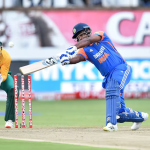Miraz Leads Fightback After Rabada Early Breakthrough. On the third morning of the first Test between Bangladesh and South Africa in Mirpur, Mehidy Hasan Miraz produced a gritty, unbeaten half-century that gave his team hope after a devastating spell by South African spearhead Kagiso Rabada. The Proteas had Bangladesh on the ropes early, but Miraz’s resilience, along with some much-needed support from debutant Jaker Ali, brought the hosts back into the contest as they aimed to avert an innings defeat.
At lunch, Bangladesh were 201 for six in their second innings, just a run shy of forcing South Africa to bat again. Miraz was on 55 from 107 balls, and Ali, in his maiden Test innings, was providing invaluable assistance with 30 to his name. Together, they added 89 runs in 172 balls, setting a new seventh-wicket record for Bangladesh against South Africa. Despite the early breakthroughs, Bangladesh ended the session with some renewed optimism.
Rabada Destructive Opening Spell
South Africa entered the morning session with momentum firmly on their side. Having dismissed Bangladesh for a modest total in the first innings and built a commanding lead, Kagiso Rabada wasted no time in driving the advantage home on Day 3. The fast bowler made a significant breakthrough in just his second over, dismissing the two overnight batters in quick succession.
Mahmudul Hasan Joy was the first to go, edging a loose shot into the hands of David Bedingham at second slip after making a composed 40 off 92 deliveries. Just two balls later, Rabada struck again, this time with a beauty that pierced Mushfiqur Rahim’s defenses, clean-bowling the experienced batter for 33. Mushfiqur’s dismissal mirrored his first-innings downfall, where Rabada had also found a way through his technique.
With Bangladesh now reeling at 112 for six, still trailing South Africa by 90 runs, a quick finish seemed likely. South Africa could practically taste victory, with the Proteas captain Aiden Markram marshaling his troops expertly, putting the pressure on Bangladesh to avoid an innings defeat.
Maharaj Joins the Party
Kagiso Rabada wasn’t the only South African bowler causing havoc on the Mirpur pitch. Shortly after Rabada’s double strike, left-arm spinner Keshav Maharaj got in on the action, dismissing Litton Das to leave Bangladesh in further disarray.
Litton had attempted to push forward defensively, but the ball from Maharaj spun sharply away from him, catching a faint edge. Initially given not out, Markram opted for a late review, which showed a thin nick on the UltraEdge, reversing the decision and sending Das back to the pavilion. This dismissal was a significant moment, as Litton is known for his ability to accelerate the scoring when needed, and Bangladesh could ill afford to lose his wicket in such a crucial phase of the match.
Maharaj’s success further solidified South Africa’s dominance, as Bangladesh were now in a perilous position at 112 for six. The hosts were struggling, and the South African bowlers were relentless. Maharaj, known for his ability to generate spin on any surface, continued to apply pressure on the Bangladeshi batters. At the end of the session, Maharaj’s figures stood at 2/70 from 26 overs, showcasing his consistency and control.
Miraz Fights Back for Bangladesh
Amid the chaos and the fall of wickets, Mehidy Hasan Miraz was determined to turn the tide for his team. As Bangladesh’s lower order crumbled around him, Miraz took it upon himself to lead the resistance. His unbeaten 55 off 107 balls was a perfect blend of patience, skill, and determination. Despite being known primarily as an all-rounder, Miraz showcased the temperament of a seasoned top-order batter.
The fightback was not Miraz’s alone, however. Debutant Jaker Ali played a crucial supporting role, with the pair managing to bat for long periods against a potent South African attack. The duo added 89 runs for the seventh wicket, the highest stand for Bangladesh against South Africa in Test cricket for this wicket. The partnership breathed new life into a Bangladeshi innings that had seemed doomed.
Miraz was particularly effective against the off-spin of Dane Piedt, who struggled with consistency. Miraz punished anything loose, at one point lofting Piedt for a straight six, a shot that demonstrated his growing confidence. Piedt’s 11 overs went for 61 runs, as Bangladesh’s lower order managed to score freely off him, with Miraz being the chief aggressor.
At the other end, Jaker Ali was solid, showing remarkable composure for a debutant. His defense was steadfast, and he proved to be the perfect foil for the more attacking Miraz. Together, they frustrated South Africa’s bowlers, keeping the game alive for Bangladesh.
South Africa Bowlers Stay Patient
While Rabada and Maharaj were the standout performers, South Africa’s bowlers as a unit remained patient throughout the session, sticking to their plans and waiting for opportunities to arise. Rabada, in particular, was menacing with his pace and accuracy, finishing the session with figures of 4/35 in 15 overs. His ability to move the ball both ways, combined with his raw pace, made him a constant threat.
Keshav Maharaj, despite being taken for a few runs by Miraz and Ali, also maintained pressure from his end. His control over line and length forced the batters to play, and the wickets he took were crucial in keeping South Africa ahead in the match. Although he went wicketless in the latter part of the session, Maharaj’s variations in flight and spin remained a challenge for the Bangladeshi batters.
A Glimmer of Hope for Bangladesh
Despite South Africa’s dominant position in the match, the partnership between Miraz and Ali offered Bangladesh a faint glimmer of hope. At 201 for six, they were just one run away from forcing South Africa to bat again, and with Miraz set and Ali looking comfortable, the hosts would have felt a sense of optimism going into the lunch break.
Bangladesh still had a mountain to climb, but if Miraz and Ali could continue their partnership and the remaining batters could contribute, they might just be able to set South Africa a small target to chase in the fourth innings. While the odds were stacked against them, cricket is a game of uncertainties, and Bangladesh would not have given up hope yet.
Conclusion
As the third day of the first Test progressed, South Africa remained firmly in control, but Mehidy Hasan Miraz’s fighting half-century gave Bangladesh a chance to stay alive in the contest. The partnership between Miraz and Jaker Ali was one of resilience and skill, keeping the Proteas bowlers at bay and frustrating their attempts to wrap up the match early.












